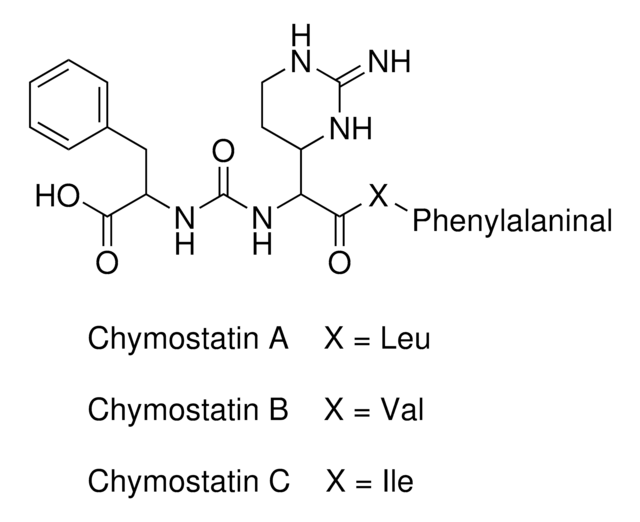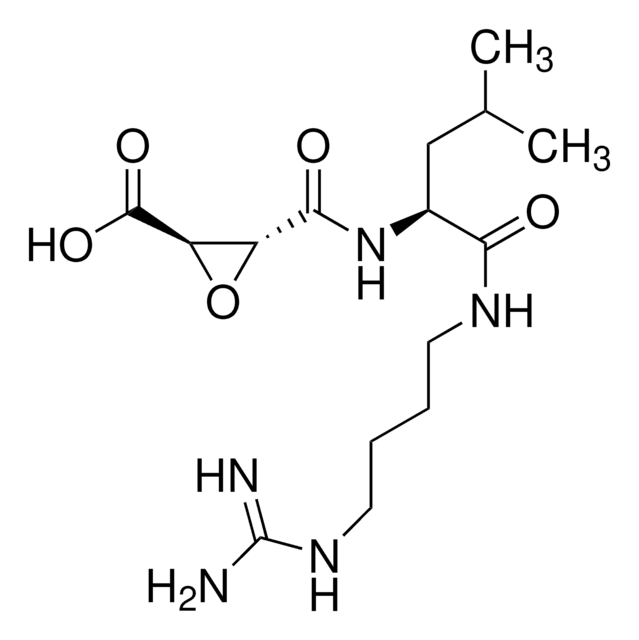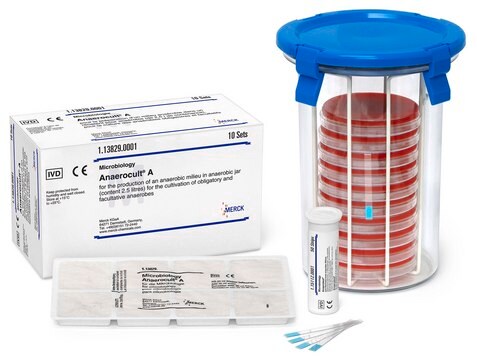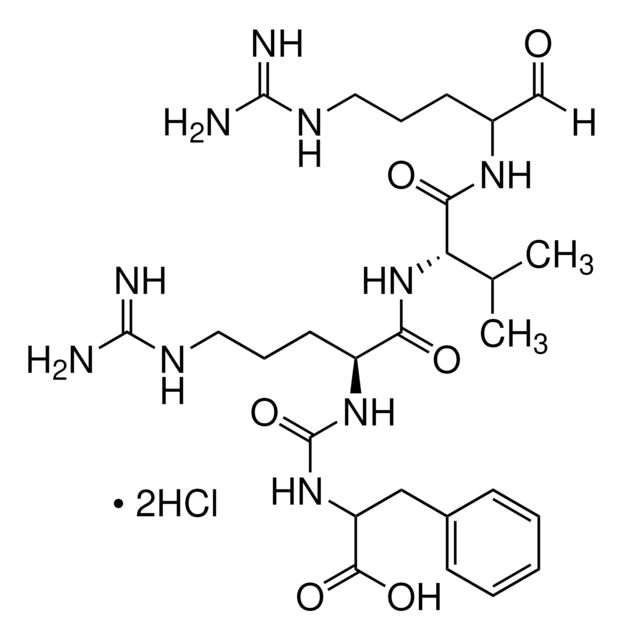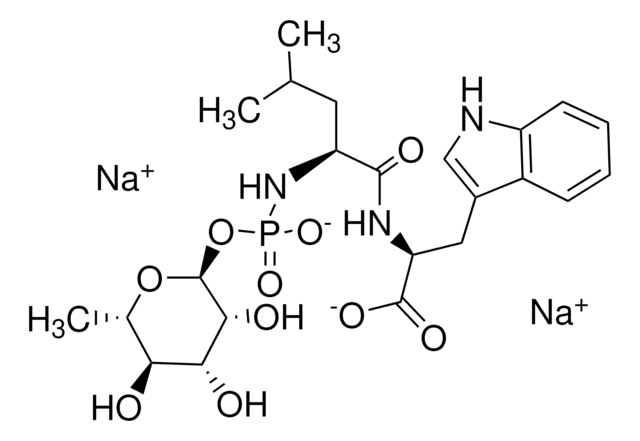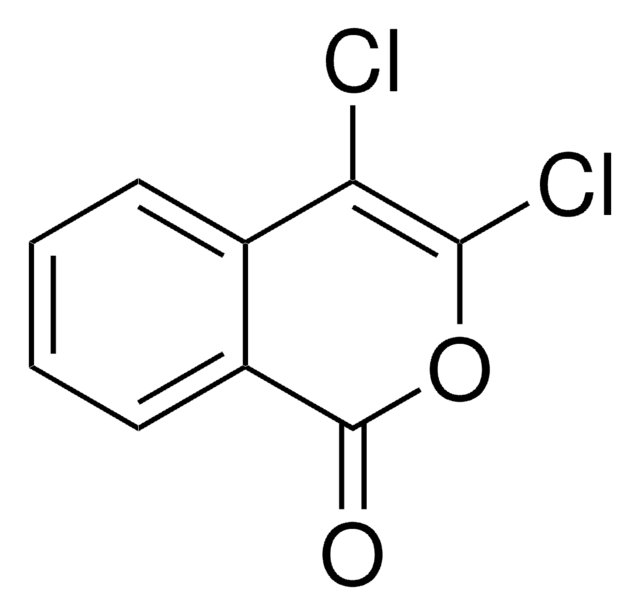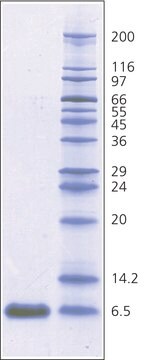11004638001
Roche
Chymostatin
Synonym(s):
Chymostatin, N-(Nα-Carbonyl-Cpd-X-Phe-al)-Phe (Cpd = capreomycidine) (capreomycidine = [S,S]-α-(2-Iminohexahydro-4-pyrimidyl)glycine)
Sign Into View Organizational & Contract Pricing
All Photos(1)
About This Item
Recommended Products
form
powder
Quality Level
mol wt
Mr = 607.71
packaging
pkg of 10 mg
manufacturer/tradename
Roche
mp
205 °C
solubility
acetic acid: soluble 20 mg/mL
storage temp.
2-8°C
SMILES string
OC(C(NC(NC(C1NC(NCC1)=N)C([F,Cl,Br,I]C)=O)=O)CC2=CC=CC=C2)=O
InChI key
MRXDGVXSWIXTQL-HYHFHBMOSA-N
Looking for similar products? Visit Product Comparison Guide
General description
Chymostatin is a mixture of three components, A, B, and C. The component A being N-[((S)-1-carboxy-2-phenylethyl)-carbamoyl]-α-[2-iminohexahydro-4(S)-pyrimidyl]-L-glycyl-L-leucyl-phenylalaninal. The other two components B and C differ in that the L-leucyl residue is substituted by L-valine and L-isoleucine, respectively.
Application
Chymostatin is a specific inhibitor of α-, β-, γ-, and δ-chymotrypsin.
Biochem/physiol Actions
Chymostatin is a strong inhibitor of many proteases, including chymotrypsin, papain, chymotrypsin-like serine proteinases, chymases, and lysosomal cysteine proteinases such as cathepsins A,B,C, B, H, and L. It weakly inhibits human leucocyte elastase. It is effective at a final concentration of 100 to 200 μg/ml (10 to 100 μM). Chymostatin is often included in protease inhibitor cocktails used with plant extracts.
Quality
Performance tested.
Formula variant
C31H41N7O6
Preparation Note
Working concentration: 6 to 60 μg/ml (10 to 100 μM)
1 U chymotrypsin is inhibited to 49% of the original activity by 1.8 μg of chymostatin.
Thin-layer chromatography: butanol/methanol/H2O = 4 / 1 / 2
Working solution: Soluble in glacial acetic acid or DMSO to 20 mg/ml. Sparingly soluble in water, methanol, or ethanol. Insoluble in ethyl acetate, petroleum and ethyl ethers, hexane, or chloroform (CHCl3).
It is recommended to dissolve the inhibitor in 1% acetic acid in higher concentration and to adjust the concentration wanted with phosphate buffer, 0.05 M, pH 7.0, which is common for chymotrypsin assay.
CAUTION: DMSO (Dimethyl sulfoxide) will permeate the skin, carrying solubilized protease inhibitors. Always wear appropriate protection for eyes, skin, etc.
Storage conditions (working solution): -15 to -25 °C
Dilute solutions should be stored frozen in aliquots at -15 to -25 °C and are stable for approximately one month. Avoid repeated freezing. Growth of microorganisms should be avoided as proteases from microbial origin may hydrolyze the peptides.
1 U chymotrypsin is inhibited to 49% of the original activity by 1.8 μg of chymostatin.
Thin-layer chromatography: butanol/methanol/H2O = 4 / 1 / 2
Working solution: Soluble in glacial acetic acid or DMSO to 20 mg/ml. Sparingly soluble in water, methanol, or ethanol. Insoluble in ethyl acetate, petroleum and ethyl ethers, hexane, or chloroform (CHCl3).
It is recommended to dissolve the inhibitor in 1% acetic acid in higher concentration and to adjust the concentration wanted with phosphate buffer, 0.05 M, pH 7.0, which is common for chymotrypsin assay.
CAUTION: DMSO (Dimethyl sulfoxide) will permeate the skin, carrying solubilized protease inhibitors. Always wear appropriate protection for eyes, skin, etc.
Storage conditions (working solution): -15 to -25 °C
Dilute solutions should be stored frozen in aliquots at -15 to -25 °C and are stable for approximately one month. Avoid repeated freezing. Growth of microorganisms should be avoided as proteases from microbial origin may hydrolyze the peptides.
Solubility testing in glacial acetic acid at 10 mg/ml yields a clear solution, which is usually colorless, but can be yellow in appearance. It is reportedly also soluble in DMSO; only slightly soluble in water and short-chain alcohols; insoluble in ethyl acetate, butyl acetate, ether, hexane, and petroleum ether. Stock solutions (10 mM) can be prepared in DMSO and are stable for months at -20 °C. Stock solutions can also be made in 0.1 M HCl. Dilute solutions (10-100 μM) are only stable for several hours, due to oxidation of the terminal aldehyde.
Other Notes
For life science research only. Not for use in diagnostic procedures.
Storage Class Code
11 - Combustible Solids
WGK
WGK 1
Flash Point(F)
Not applicable
Flash Point(C)
Not applicable
Choose from one of the most recent versions:
Already Own This Product?
Find documentation for the products that you have recently purchased in the Document Library.
Customers Also Viewed
The structure of chymostatin, a chymotrypsin inhibitor.
K Tatsuta et al.
The Journal of antibiotics, 26(11), 625-646 (1973-11-01)
Verena van der Heide et al.
Cell reports, 38(11), 110508-110508 (2022-03-06)
Concerns that infection with severe acute respiratory syndrome coronavirus 2 (SARS-CoV-2), the etiological agent of coronavirus disease 2019 (COVID-19), may cause new-onset diabetes persist in an evolving research landscape, and precise risk assessment is hampered by, at times, conflicting evidence.
Our team of scientists has experience in all areas of research including Life Science, Material Science, Chemical Synthesis, Chromatography, Analytical and many others.
Contact Technical Service